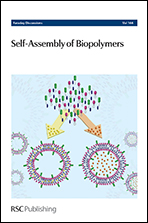Electrostatic interaction of heterogeneously charged surfaces with semipermeable membranes
Abstract
In this paper we study the electrostatic interaction of a heterogeneously charged wall with a neutral semipermeable membrane. The wall consists of periodic stripes, where the charge density varies in one direction. The membrane is in contact with a bulk reservoir of an electrolyte solution and separated from the wall by a thin film of salt-free liquid. One type of ions (small counterions) permeates into the gap. This gives rise to a distance-dependent membrane potential, which translates into a repulsive electrostatic disjoining pressure due to an overlap of counterion clouds in the gap. To quantify it we use two complementary approaches. First, we propose a mean-field theory based on a linearized Poisson–Boltzmann equation and Fourier analysis. These calculations allow us to estimate the effect of a heterogeneous charge pattern at the wall on the induced heterogeneous membrane potential, and the value of the disjoining pressure as a function of the gap. Second, we perform Langevin dynamics simulations of the same system with explicit ions. The results of the two approaches are in good agreement with each other at low surface charges and small gaps, but differ due to nonlinearity at higher charges. These results demonstrate that a heterogeneity of the wall charge can lead to a huge reduction in the electrostatic repulsion, which could dramatically facilitate self-assembly in complex synthetic and biological systems.
- This article is part of the themed collection: Self-Assembly of Biopolymers

 Please wait while we load your content...
Please wait while we load your content...